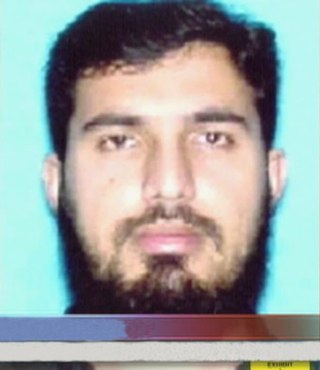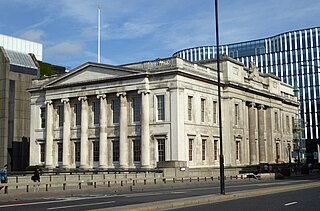
The Buffalo Six is a group of six Yemeni-American friends who pled guilty to charges of providing material support to al-Qaeda in December 2003, based on their having attended an al-Qaeda training camp in Afghanistan together in the Spring of 2001. The suspects were facing likely convictions with steeper sentences under the "material support law" which requires no proof that a defendant engaged in terrorism, aided or abetted terrorism, or conspired to commit terrorism.
Abdul Nacer Benbrika, also known as Abu Bakr, is a convicted criminal, currently serving an Australian custodial sentence of fifteen years, with a non-parole period of twelve years for intentionally being the leader and a member of a terrorist organisation. Benbrika was one of 17 men arrested in the Australian cities of Sydney and Melbourne in November 2005, charged with being members of a terrorist organisation and of planning terrorist attacks on targets within Australia. Benbrika is alleged to be the spiritual leader of the group. All 17 men pleaded not guilty. On 15 September 2008 Benbrika was found guilty as charged and subsequently sentenced.
The 2006 Ontario terrorism case is the plotting of a series of attacks against targets in Southern Ontario, Canada, and the June 2, 2006 counter-terrorism raids in and around the Greater Toronto Area that resulted in the arrest of 14 adults and 4 youths . These individuals have been characterized as having been inspired by al-Qaeda.
Fahim Ahmad is one of 11 people convicted in the 2006 Toronto terrorism case. He was a ringleader in the group. He was 21 years old at the time of arrest, and married with two children.
The 2004 financial buildings plot was a plan led by Dhiren Barot to attack a number of targets in the U.S. and the United Kingdom which is believed to have been approved by al-Qaeda. The evidence against the plotters consisted of home videos, written notes, and files on computers. At the time of the arrests the group had no funding, vehicles, or access to bomb-making equipment.
Terrorism in Australia deals with terrorist acts in Australia as well as steps taken by the Australian government to counter the threat of terrorism. In 2004 the Australian government has identified transnational terrorism as also a threat to Australia and to Australian citizens overseas. Australia has experienced acts of modern terrorism since the 1960s, while the federal parliament, since the 1970s, has enacted legislation seeking to target terrorism.
The Tyler poison gas plot was an American domestic terrorism plan in Tyler, Texas, thwarted in April 2003 with the arrest of three individuals and the seizure of a cyanide gas bomb along with a large arsenal. Authorities had been investigating the white supremacist conspirators for several years and the case received little media coverage and limited attention in public from the government.
Mohammad Momin Khawaja is a Canadian found guilty of involvement in a plot to plant fertilizer bombs in the United Kingdom; while working as a software engineer under contract to the Foreign Affairs department in 2004 became the first person charged and found guilty under the Canadian Anti-Terrorism Act following the proof that he communicated with British Islamists plotting a bomb attack. On March 12, 2009, Khawaja was sentenced to 10.5 years in prison and was eligible for parole five years into the prison term. On December 17, 2010, Khawaja's sentence was increased to life imprisonment by the Ontario Court of Appeals.

In the United States, a common definition of terrorism is the systematic or threatened use of violence in order to create a general climate of fear to intimidate a population or government and thereby effect political, religious, or ideological change. This article serves as a list and a compilation of acts of terrorism, attempts to commit acts of terrorism, and other such items which pertain to terrorist activities which are engaged in by non-state actors or spies who are acting in the interests of state actors or persons who are acting without the approval of foreign governments within the domestic borders of the United States.

On May 20, 2009, US law enforcement arrested four men in connection with a fake plot concocted by a Federal Bureau of Investigation (FBI) informant to shoot down military airplanes flying out of an Air National Guard base in Newburgh, New York, and blow up two synagogues in the Riverdale community of the Bronx using weapons supplied by the FBI. The group was led by Shahed Hussain, a Pakistani criminal who was working for the FBI to avoid deportation for having defrauded the New York State Department of Motor Vehicles. Hussain has never been charged in the United States with any terrorism related offenses and was paid nearly US$100,000 by the FBI for his work on this plot.
The 2005 Sydney terrorism plot concerned a group of five men arrested in 2005 on charges of planning an act of terrorism targeting Sydney, Australia's most populous city and the capital of New South Wales. The group was found guilty on 16 October 2009 and were sentenced on 15 February 2010 for terms up to 28 years.
The 2009 New York City Subway and United Kingdom plot was a plan to bomb the New York City Subway as well as a target in the United Kingdom.

Najibullah Zazi is an Afghan-American who was arrested in September 2009 as part of the 2009 U.S. al Qaeda group accused of planning suicide bombings on the New York City Subway system, and who pleaded guilty as have two other defendants. U.S. prosecutors said Saleh al-Somali, al-Qaeda's head of external operations, and Rashid Rauf, an al-Qaeda operative, ordered the attack. Both were later killed in drone attacks.
Colleen Renée LaRose, also known as Jihad Jane and Fatima LaRose, is an American citizen who was convicted and sentenced to 10 years for terrorism-related crimes, including conspiracy to commit murder and providing material support to terrorists.

On 29 November 2019, five people were stabbed, two fatally, in Central London. The attacker, Usman Khan, had been released from prison in 2018 on licence after serving a sentence for terrorist offences.

Usman Khan, also known as Abu Saif, was a Pakistani-British terrorist who was convicted of plotting a terrorist attack in 2012. He was shot dead by City of London Police after being restrained by members of the public whilst committing a knife attack near London Bridge on 29 November 2019, where he killed two people and injured three others.
Operation Guava is the code name for a long-term British Security Service (MI5) operation. The operation tracked a terrorist cell, which planned "a significant terrorist plot." The Operation Guava plotters used the Al-Qaeda in the Arabian Peninsula magazine Inspire as an instruction manual for the bomb they planned to leave in a toilet stall at the London Stock Exchange.






